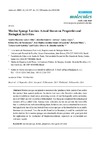Identificador persistente para citar o vincular este elemento:
https://accedacris.ulpgc.es/handle/10553/46015
| Campo DC | Valor | idioma |
|---|---|---|
| dc.contributor.author | Filho, Sandro Mascena Gomes | en_US |
| dc.contributor.author | Cardoso, Juscélio Donizete | en_US |
| dc.contributor.author | Anaya, Katya | en_US |
| dc.contributor.author | Do Nascimento, Edilza Silva | en_US |
| dc.contributor.author | De Lacerda, José Thalles Jucelino Gomes | en_US |
| dc.contributor.author | Mioso, R. | en_US |
| dc.contributor.author | Gadelha, Tatiane Santi | en_US |
| dc.contributor.author | De Almeida Gadelha, Carlos Alberto | en_US |
| dc.date.accessioned | 2018-11-23T00:38:57Z | - |
| dc.date.available | 2018-11-23T00:38:57Z | - |
| dc.date.issued | 2015 | en_US |
| dc.identifier.issn | 1420-3049 | en_US |
| dc.identifier.uri | https://accedacris.ulpgc.es/handle/10553/46015 | - |
| dc.description.abstract | Marine sponges are primitive metazoans that produce a wide variety of molecules that protect them against predators. In studies that search for bioactive molecules, these marine invertebrates stand out as promising sources of new biologically-active molecules, many of which are still unknown or little studied; thus being an unexplored biotechnological resource of high added value. Among these molecules, lectins are proteins that reversibly bind to carbohydrates without modifying them. In this review, various structural features and biological activities of lectins derived from marine sponges so far described in the scientific literature are discussed. From the results found in the literature, it could be concluded that lectins derived from marine sponges are structurally diverse proteins with great potential for application in the production of biopharmaceuticals, especially as antibacterial and antitumor agents. | en_US |
| dc.language | eng | en_US |
| dc.relation.ispartof | Molecules | en_US |
| dc.source | Molecules [1420-3049], v. 20 (1), p. 348-357 | en_US |
| dc.subject | 2415 Biología molecular | en_US |
| dc.subject | 23 Química | en_US |
| dc.subject.other | Marine sponge | en_US |
| dc.subject.other | Lectins | en_US |
| dc.subject.other | Properties | en_US |
| dc.subject.other | Biological activities | en_US |
| dc.title | Marine sponge lectins: actual status on properties and biological activities | en_US |
| dc.type | info:eu-repo/semantics/review | es |
| dc.type | Article | es |
| dc.identifier.doi | 10.3390/molecules20010348 | - |
| dc.identifier.scopus | 84921680358 | - |
| dc.contributor.authorscopusid | 56492510600 | - |
| dc.contributor.authorscopusid | 26649783600 | - |
| dc.contributor.authorscopusid | 56492939200 | - |
| dc.contributor.authorscopusid | 56492530600 | - |
| dc.contributor.authorscopusid | 55963319600 | - |
| dc.contributor.authorscopusid | 55535031500 | - |
| dc.contributor.authorscopusid | 7801650357 | - |
| dc.contributor.authorscopusid | 40161177400 | - |
| dc.description.lastpage | 357 | - |
| dc.identifier.issue | 1 | - |
| dc.description.firstpage | 348 | - |
| dc.relation.volume | 20 | - |
| dc.investigacion | Ciencias | en_US |
| dc.type2 | Reseña | en_US |
| dc.identifier.ulpgc | Sí | es |
| dc.description.sjr | 0,562 | |
| dc.description.jcr | 2,465 | |
| dc.description.sjrq | Q1 | |
| dc.description.jcrq | Q2 | |
| dc.description.scie | SCIE | |
| item.fulltext | Con texto completo | - |
| item.grantfulltext | open | - |
| crisitem.author.orcid | 0000-0003-1369-2037 | - |
| crisitem.author.fullName | Mioso, Roberto | - |
| Colección: | Reseña | |
Citas SCOPUSTM
18
actualizado el 08-jun-2025
Citas de WEB OF SCIENCETM
Citations
14
actualizado el 08-jun-2025
Visitas
63
actualizado el 18-nov-2023
Descargas
114
actualizado el 18-nov-2023
Google ScholarTM
Verifica
Altmetric
Comparte
Exporta metadatos
Los elementos en ULPGC accedaCRIS están protegidos por derechos de autor con todos los derechos reservados, a menos que se indique lo contrario.
